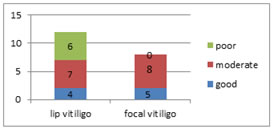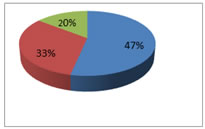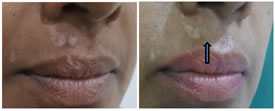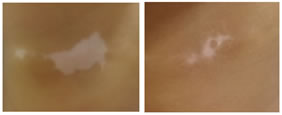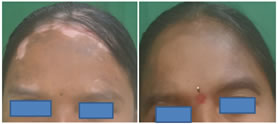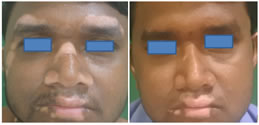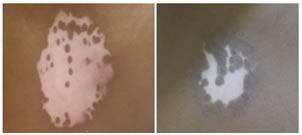|
Table of Content - Volume 20 Issue 3 - December 2021
Study of efficacy of excimer laser in localised vitiligo
Chaithanya K1, M Madhavi Latha2*, T Praveena3
1,2Post Graduate, 2Professor, 3Associate professor, Department of DVL, Santhiram Medical College and General Hospital, NH-40, Nandyal, Andhra Pradesh, INDIA. Email: chaithanyareddy94@gmail.com, vc.madhavi@gmail.com, praveenathiriveedhi@gmail.com.
Abstract Background: Vitiligo is an acquired, often progressive disorder of hypopigmentation, clinically manifested by circumscribed achromic macules often associated with leukotrichia. The estimated incidence in India is 3%-4%. various modalities of treatment have been tried with variable outcomes. Aim: To study the effect of Excimer laser (308-nm UVB radiation) in patients with localized vitiligo. Methods: Thirty patients (19 females, 11 males) with localized vitiligo, denovo, or who had tried various modalities of treatment (including topical and systemic drugs) were enrolled in the study. Of the 30 subjects, 17 had lip vitiligo, 13 had focal vitiligo (over elbows, wrist, dorsum of the hand, and foot). Treatment with excimer laser was done twice or thrice weekly after calculating MED dose and increased by 20mj/cm2 in every session. Objective and subjective assessment was done after every 2 months. Results: At the end of the study period, 47% (14/30) of patients showed good response in lesions located on the face, trunk, arm, and/or leg (high-responder location), and after 15 sessions, 33% (10/30) of patients showed a moderate response in lesions located on the elbow, wrist, dorsum of the hand, knee, and/or dorsum of the foot (low-responder location),20% (6/30) of patients showed poor response. Conclusion: 308nm excimer laser is effective in patients with localized vitiligo. However, the therapeutic effect is mainly dependent on the location of vitiligo lesions.
INTRODUCTION Vitiligo is an acquired, often progressive disorder of hypopigmentation, clinically manifested by circumscribed achromic macules often associated with leukotrichia. Both genetic and epigenetic factors seem to play a role in the etiopathogenesis of vitiligo. Vitiligo is associated with many skin disorders like canities, alopecia areata, atopic eczema, thyroiditis, diabetes mellitus. It commonly involves people with 3 and 4 fitzpatrick skin types and a higher incidence among patients with atopic dermatitis. Excimer laser in which “excimer” is a terminological reference of “excited dimer”. The 308 nm excimer laser, a xenon-chloride excimer laser, a novel mode of phototherapy, is an ultraviolet B radiation system consisting of noble gas and halide which repel each other. The mechanism of action of the excimer laser, similar to the action of UVB light, induces apoptosis in keratinocytes and T lymphocytes. It is recommended when the lesions involve less than 20% of the body, treatment is given twice or thrice weekly.
MATERIALS AND METHODS An observational prospective study was conducted in patients presenting with vitiligo to the outpatient department of DVL of Santhiram Medical College and General Hospital, Nandyal, from November 2020 to April 2021. The institutional committee approval was taken and written informed consent was taken from all study subjects Patients are those who are willing to give informed written consent and who are willing to participate in the study. Patients having localized patches of vitiligo, denovo, or who had tried various modalities of treatment (including topical and systemic drugs). Patients of ages (10-50 years) and both sexes were included in the study. Widespread lesions, pregnancy and lactating, and patients having a history of photosensitivity were excluded. Patients with other hypopigmented skin lesions and not clinically correlating with a diagnosis of vitiligo were excluded from the study. Detailed history and complete cutaneous examination were done. Based on the vitiligo activity, a score was assigned which is a 6 point scale for evaluating vitiligo activity, based on the patient's reports of disease activity. This was calculated and scored as: 4+ (active in past 6 weeks);3+ (active in past 3 months); 2+ (active in past 6 months); 1+ (active in past 1 year); 0 (stable for at least 1 year); 1- (stable for at least 1 year with spontaneous repigmentation). Digital photographs were taken. Excimer laser irradiation was started after calculating MED dose and increased by 20mJ/cm2 for every two sessions after taking necessary precautions as protecting eyes and surrounding normal skin. Objective (Visual assessment which includes physician’s global assessment, visible light photography, UV light photography) and subjective assessment (vitiligo disease activity score) were done after 2, 4 and 6 months. Less than 25% improvement after treatment was considered as a failure to treat, 25%-50% as a poor response, 50%-75% as a good response, and >75% as an excellent response.
RESULTS This study sample consisted of 30 patients, where the majority belonging to the age group of 30-40 years. Six cases had a positive family history. Vitiligo was associated with other diseases as Diabetes Miletus in 14 cases, Thyroid disorder in 11 cases, Alopecia areata in 1case, and Atopic dermatitis in 4 cases. Repigmentation started over the lesions after an average of 13 treatments, lesions located on the face, trunk, arm, and/or leg (high-responder location), and after a mean of 22 treatments in lesions located on the elbow, wrist, dorsum of the hand, knee, and/or dorsum of the foot (low-responder location). Lips were most commonly involved followed by the elbow, wrist, dorsum of foot, dorsum of the hand. Of 17 patients who had lip vitiligo, 4 (23.5%) patients achieved a good response, 7 (41.1%) patients achieved a moderate response, 6 (35%) achieved a poor response. Of 13 focal vitiligo patients, 5 patients having lesions over trunk and waist achieved good response (38%), 8 patients having lesions over acral areas achieved poor response (61.5%). At the end of 10 sessions, 47% (14/30) of patients showed good response, 33% (10/30) of patients showed a moderate response, 20% (6/30) of patients showed a poor response at the end of 15sessions The ultimate repigmentation initiation depends entirely on the total number of treatment sessions rather than the frequency
TABLE 1: Age distribuition
TABLE 2: Sex distribuition
TABLE 3: Distribuition of disease
TABLE 4: Association with other diseases
TABLE 5: Association with family history
Chart 1: bar graph showing results based on location Chart 2: pie diagram showing results after treatment Figure 1 Figure 2 Figure 3 Figure 4 Figure 5 Figure 6 Figure 7 Figure 8 Figure 9 Figure 10
DISCUSSION Excimer laser is a form of ultraviolet laser, is a newer treatment option that can induce repigmentation without global radiation exposure. It acts through immunomodulation by affecting the T cells represents the latest advance in the treatment of chronic stable vitiligo, with good results achieved in a relatively short duration of time. The use of a monochromatic wavelength of 308 nm gives photobiological effects superior to those provided by NB-UVB. The main targets for UV-B are DNA contained in epidermal cells (keratinocytes, melanocytes) and to a lesser extent, in dermal cells (fibroblasts). Inflammatory reactions could also be involved. According to Al-Otaibi SR, et al. (2009), Thirty-four patients (14 males and 20 females) with localized vitiligo were treated using a 308-nm excimer laser twice weekly for 13 weeks with a dose started with 50 to 100 mj/cm2 (according to the site) and increased by 50 mJ/cm2 in every session until erythema appeared for 25 sessions, or until 100% repigmentation. In our study, almost all patients developed repigmentation, 14 patients (47%) achieved good results, and 10 patients (30%) achieved moderate results. Those lesions on the lips and acral areas responded very poorly as expected from most of the literature. Repigmentation started in the 2nd month in most of the patients. It was usually given for stable, localized vitiligo. But in our study, it was given for localized progressive vitiliginous patches too where it not only stopped the progression of the lesion, it also helped in repigmentation. Regarding the safety, except for transient erythema which lasted for 3-4 days, no other serious side effect was encountered during the study period.
CONCLUSION The present study reveals that vitiligo has a more female preponderance of 30-40 yrs of age. The most frequent associations observed in this study were, diabetes Miletus, thyroid disorder, atopy, alopecia areata. Family history also has a relation with vitiligo. VIDA, which is a subjective, objective, and the reproducible tool was used to follow up and assess therapeutic responses that can maintain the data in a photographic record. We recommend further studies on a larger population to optimize this novel scoring system's application and utility. It is necessary to know the association of vitiligo with other disorders with essential investigations. 308nm excimer laser is effective in patients with vitiligo. However, the therapeutic effect is mainly dependent on the location of vitiligo lesions and entirely on the total number of treatment sessions rather than frequency.
REFERENCES
Policy for Articles with Open Access
|
|
 Home
Home
